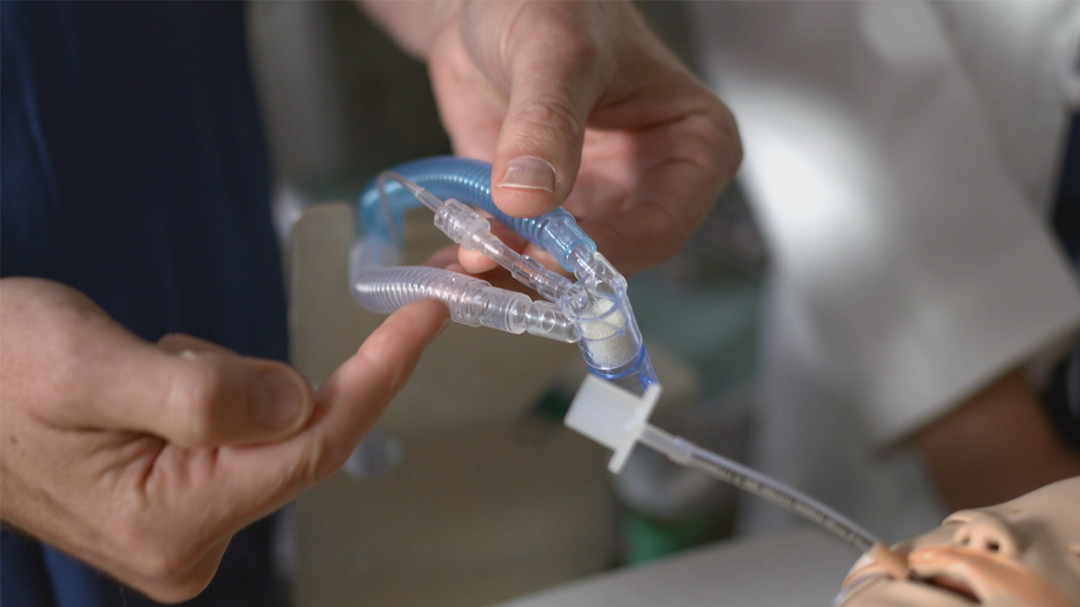John Tolley, January 1, 2020
During surgery, anesthesiologists ensure that a patient remains unconscious during the procedure. They also maintain vital functioning, such as that of the respiratory system. When that patient is an infant or young child, proper maintenance is a delicate balance that demands well-designed tools.
University of Wisconsin pediatric anesthesiologist Lana Volz found herself in the unenviable positions of having to deal with a cumbersome, unreliable respiration apparatus component, known as a wye, during sensitive surgeries at American Family Children?s Hospital.
?For many years I've been taking care of children in the operating room and we have this problem with the breathing circuit,? explains Volz, an associate professor of anesthesiology at Wisconsin. ?Sometimes, during surgery, the circuit falls apart and can even fall on the floor. When this happens, the baby's not receiving any oxygen and when babies don't have enough oxygen, their heart rate can decrease. If they have a slow heart rate, that means they're not getting enough blood to their brain and this can lead to severe brain damage and even death. So, this is a really serious problem and we only have a few minutes to fix it.?
Faced with an untenable situation, Volz turned to the Biomedical Engineering (BME) Design program at Wisconsin. During the program design sequence, students in this program are tasked with creating workable solutions to unmet medical needs.
Answering Volz call, several rounds of BME students contributed to design a new wye. This new circuit is more flexible with sturdier joints. It also places less torque on the airway of the patient and allows for more streamlined exchange of respiratory gases. The design team, students Lena Hampson, Sara Jorgenson and Margaret Edman, applied for a provisional patent in 2018, and have formed a company, Wye-Not Medical LLC, to bring their invention to market.
?Coming into this, it started off as a classroom project; it was BME design and we didn't really know what we were getting into,? notes Edman. ?Typically, it's just one semester and done, but so many physicians just found such great potential in it, we decided why not continue on and why not create a company and provisional patent and kind of go forth and see how far we can take this thing.?
Edman says that from the outset she and her fellow students worked alongside Volz and other physicians to gain a deeper understanding of the currently-used wye device and its shortcomings. They were aided by Russ Ward, an anesthesia clinical engineer at University of Wisconsin Hospitals.
?We got the opportunity to shadow [the physicians] and see real procedures, see a breathing circuit fall apart in the operating room in front of our eyes,? Jorgenson explains. ?That really appealed to the emotional part of it. Where before we understood it was a problem, but once when you're able to see the stress in clinician?s eyes that you know this baby's life is at risk right now, it's a really scary feeling. So, being able to be in the operating room with them and feel those same feelings as the clinicians really help us drive to a design solution.?
According to John Puccinelli, the associate chair of the undergraduate program in the Department of Biomedical Engineering, the design component of Wisconsin?s degree is unique in the freedom granted to students. While university?s offer a guided design sequence, Wisconsin is the only university to truly let students take the reins of the projects they?re overseeing.
He is also quick to note that Madison is a fertile place for those looking to launch an enterprise, a fact that was not lost on the Wye-Not Medical founders.
?I would say that this team went above and beyond,? says Puccinelli. ?They've really taken advantage of the ecosystem that Madison offers for startup companies. They've taken advantage of our Wisconsin Alumni Research Fund. They've taken advantage of the Law & Entrepreneurship Clinic here, which is another group of students trying to help out other students and other inventors on campus, and many other resources that they've actually compiled an entire list for future students to use who are going through this process. They've really taken full advantage of this this sort of startup ecosystem that Madison has.?







